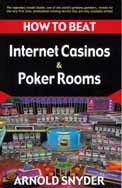
How to Beat Internet Casinos and Poker Rooms
by Arnold Snyder
Who better to teach you how to beat the online casino and poker room than a man who has been beating land-based casinos (at blackjack) for decades? Snyder reveals how you can make money olnline without any special skills, mathematical ability, super memory, difficult systems to work or eve a big bankroll. Looking at this as easy money, he explains methods of play that can multiplay your bankroll many times with little risk. The 2/3 of the book cover all the major games and promotions while the last third focuses on poker.
Play Triple-Draw Lowball at Ultimate Bet
Ultimate Bet offers triple-draw poker online. If you're looking to practice what you've learned here, it is the place to go. The site also has the full complement of games and features you would expect from a top-flight room. There's even beginner, intermediate and advanced poker strategy available.
The One Card Draw in Hold'em Poker
by Bob Ciaffone
From the title of this column, you would think I was talking about taking one card in lowball, or possibly draw high. But, in fact, there is also a "one-card draw" in hold'em. I am Bob Ciaffone is one of America’s best-known poker players, writers, and teachers. He has numerous poker tournament wins and placings, the most prominent being third place in the 1987 World Championship. He has been a poker teacher since 1995, with his students having earned well over a million dollars in tournament play. Bob's website is www.pokercoach.us referring to the situation in which there are three parts to a straight on the board and you have a card that fits in with them. This layout can provide an open-end straight draw just like the normal type (a "two-card draw," meaning both cards in your hand are used) that can complete a straight with a couple of different cards. Here is an example: You hold A-10 and the board is J-9-8 on the flop. Between your hand and the board, there is a layout of J-10-9-8, and either a queen or 7 will make a straight. This means that you have the standard number of outs for a straight draw, eight - but will the "outs" really give you a winning hand?
Bob Ciaffone is one of America’s best-known poker players, writers, and teachers. He has numerous poker tournament wins and placings, the most prominent being third place in the 1987 World Championship. He has been a poker teacher since 1995, with his students having earned well over a million dollars in tournament play. Bob's website is www.pokercoach.us referring to the situation in which there are three parts to a straight on the board and you have a card that fits in with them. This layout can provide an open-end straight draw just like the normal type (a "two-card draw," meaning both cards in your hand are used) that can complete a straight with a couple of different cards. Here is an example: You hold A-10 and the board is J-9-8 on the flop. Between your hand and the board, there is a layout of J-10-9-8, and either a queen or 7 will make a straight. This means that you have the standard number of outs for a straight draw, eight - but will the "outs" really give you a winning hand?
 Bob Ciaffone is one of America’s best-known poker players, writers, and teachers. He has numerous poker tournament wins and placings, the most prominent being third place in the 1987 World Championship. He has been a poker teacher since 1995, with his students having earned well over a million dollars in tournament play. Bob's website is www.pokercoach.us referring to the situation in which there are three parts to a straight on the board and you have a card that fits in with them. This layout can provide an open-end straight draw just like the normal type (a "two-card draw," meaning both cards in your hand are used) that can complete a straight with a couple of different cards. Here is an example: You hold A-10 and the board is J-9-8 on the flop. Between your hand and the board, there is a layout of J-10-9-8, and either a queen or 7 will make a straight. This means that you have the standard number of outs for a straight draw, eight - but will the "outs" really give you a winning hand?
Bob Ciaffone is one of America’s best-known poker players, writers, and teachers. He has numerous poker tournament wins and placings, the most prominent being third place in the 1987 World Championship. He has been a poker teacher since 1995, with his students having earned well over a million dollars in tournament play. Bob's website is www.pokercoach.us referring to the situation in which there are three parts to a straight on the board and you have a card that fits in with them. This layout can provide an open-end straight draw just like the normal type (a "two-card draw," meaning both cards in your hand are used) that can complete a straight with a couple of different cards. Here is an example: You hold A-10 and the board is J-9-8 on the flop. Between your hand and the board, there is a layout of J-10-9-8, and either a queen or 7 will make a straight. This means that you have the standard number of outs for a straight draw, eight - but will the "outs" really give you a winning hand?The reason for this column is that I see this one-card holding overrated by many hold'em players, and I want to illustrate to you how poor it really is. So, I call it a "one-card straight draw," to distinguish it from a normal straight draw, such as J-10 in your hand and 9-8 on the board, which is a "two-card straight draw" because both cards in your hand are used in the straight.
When a person learns something new, a typical error is to link dissimilar items as equivalent because they fall under the same general category. For the poker player, the broad category is "eight-way straight draw," and the error is failing to discriminate in hold'em between a one-card draw and a two-card draw. Let's look at some reasons why I am about to issue a small tirade against the one-card straight draw.
First, with a one-card draw, you are not drawing to the nuts most of the time. In the given situation when you hold A-10 with a board of J-9-8, someone could have a K-10. In this case, the queen that gives you a queen-high straight gives your opponent a king-high straight. It is possible to have a one-card draw that is to the nuts if you have your other card working in the straight, as the K-10 does here. But note that the 7 that makes your straight on the low end does not give you a nut holding. We can conclude that a one-card draw that also has a card that will become part of the straight if you hit it, such as our K-10 here, is superior to the typical one-card draw but still inferior to a two-card draw. You also can be drawing to the nuts if your straight is ace-high. For example, if the board is K-J-10 and you have a queen (Q-2 in the blind is an example hand), an ace will give you the nuts. Of course, a 9 will not, so your draw is similar to the K-10 we discussed, as it's to the nuts only on the top end. This draw with the queen is inferior to the K-10 draw, though, because nobody can hit a smaller straight and get into trouble.
The second drawback to the one-card draw is that you are in much more danger of tying when you make your hand. All an opponent needs is the same key card that you have. With a board of K-J-10 and your hand of Q-2, it would not be at all surprising to have a split pot. A two-way split is common, and a four-way split is possible. You can have someone else drawing to the same hand, or someone may already have the hand you are hoping to make. With a two-card draw to a straight, a split is, of course, also possible, but a lot less likely than when all an opponent needs to do is match one of your cards.
The third drawback to the one-card draw is that the implied odds are worse. The implied odds are the extra money you expect to get after making your hand (in addition to what is already in the pot). Suppose you have that A-10 with a flop of J-9-8. You need a queen or a 7, but either of them will put a four-straight on the board. Looking at a board of Q-J-9-8 is pretty terrifying to someone who does not have a straight. It would be unusual for someone to bet your hand for you. Even top set is likely to just check and call. You simply cannot make as much money after hitting if there are four parts to a straight on the board instead of only three.
One of the little tricks of a no-limit player is to take a card off to a gutshot if the card needed also makes a straight for a one-card draw. (You can of course do the same thing in limit poker, but there, drawing to an inside straight is a pretty normal play - whether it is right or wrong in a given situation.) Here is an example: The flop is 9-8-6. If there's a bet and call in front of you, you may decide to take a card off with your Q-J even with a pot-size bet, if there is a lot of money left. The 10 that gives you a straight also makes a straight for anyone with a 7 in his hand. On your good days, you'll catch someone with a J-7, and a double-up is the likely result. The corollary of this is that the 7 has no business in the pot in the first place. In no-limit, I would rather have a gutshot at the nuts than an open-end straight draw at a potential disaster.
I will acknowledge that there are times in hold'em when you will want to play a one-card draw to a straight. But keep in mind that it is similar to drawing to a flush with the board paired. You make these plays when a lot of money is in the pot preflop and you are playing limit poker. If you are about a 5-1 dog to make your hand and are getting 15-1 or 20-1 pot odds, it is probably right to draw to non-nut hands. You can afford to hit and lose a few times and still be better off playing the hand. It is not my goal to get you to automatically throw such hands in the muck every time. But you do need to go into these situations with an awareness of the defects of your one-card draw, and take these defects into consideration when weighing whether and how to play your hand. Much of the time, folding is the long-run favorite to be the right play with a one-card draw in hold'em.
[ learn to play poker! ]

